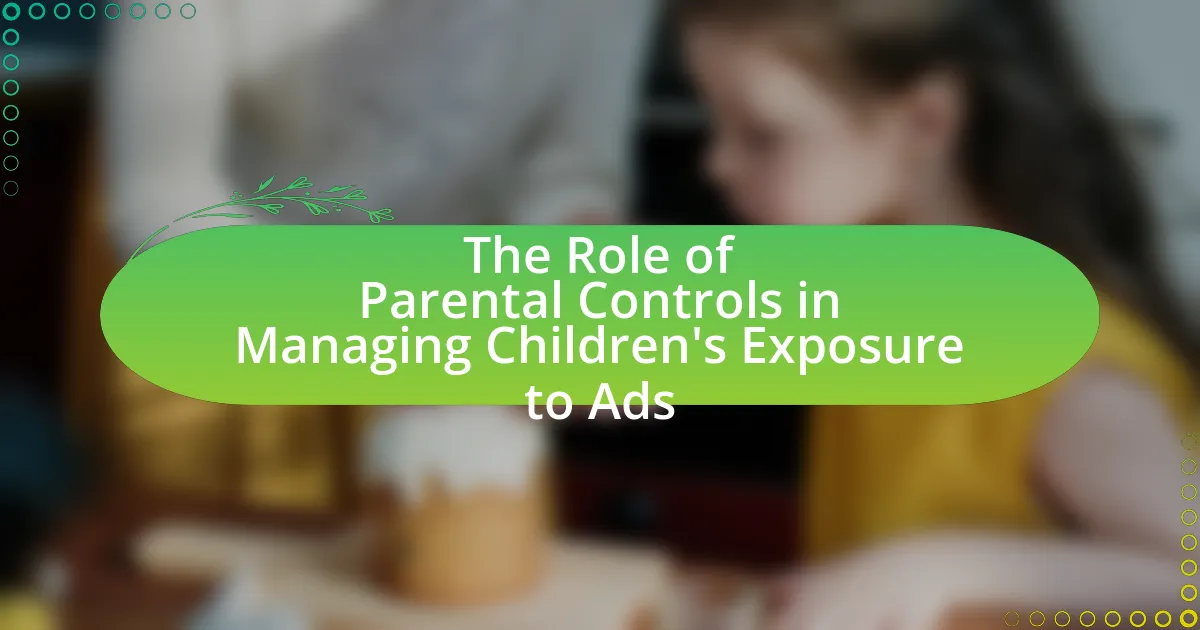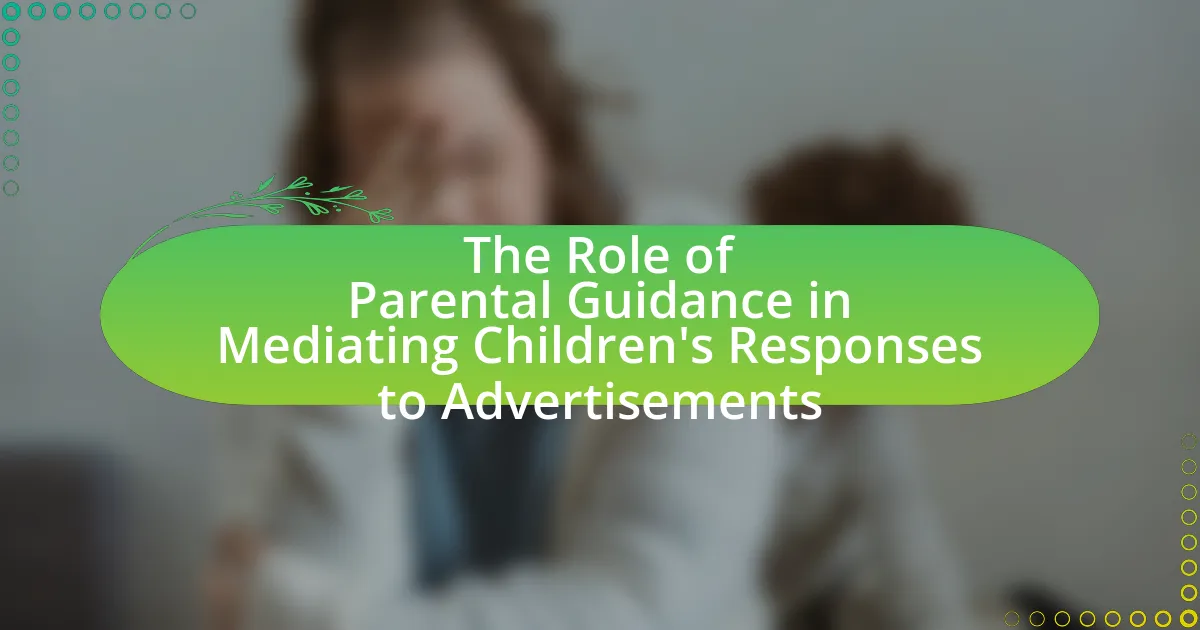The article examines the impact of commercials on children’s self-esteem from a parental perspective, highlighting how advertisements promote unrealistic standards of beauty and success. Research indicates that exposure to idealized images in commercials can lead to body dissatisfaction and lower self-worth among children, particularly affecting their self-image and perceptions of materialism. It discusses the role of parental guidance in mediating these effects, emphasizing the importance of open communication and critical analysis of advertising messages. Additionally, the article outlines common themes in children’s commercials, the developmental stages that influence their responses, and practical strategies for parents to foster a positive media environment and support their children’s self-esteem.
What is the effect of commercials on children’s self-esteem?
Commercials negatively affect children’s self-esteem by promoting unrealistic standards of beauty and success. Research indicates that exposure to idealized images in advertisements can lead to body dissatisfaction and lower self-worth among children. A study published in the journal “Pediatrics” by authors such as Harrison and Hefner found that children who frequently view commercials are more likely to internalize these unrealistic ideals, resulting in increased feelings of inadequacy and lower self-esteem.
How do commercials influence children’s perceptions of themselves?
Commercials significantly influence children’s perceptions of themselves by promoting idealized images and lifestyles that children may aspire to emulate. Research indicates that exposure to advertisements often leads children to develop unrealistic standards of beauty and success, which can negatively impact their self-esteem. For instance, a study published in the journal “Pediatrics” found that children who frequently view commercials featuring thin, attractive models are more likely to express dissatisfaction with their own bodies and self-worth. This correlation highlights how targeted marketing strategies can shape children’s self-image and contribute to feelings of inadequacy.
What specific messages in commercials impact children’s self-image?
Commercials often convey messages that equate self-worth with material possessions, beauty standards, and social status, significantly impacting children’s self-image. For instance, advertisements frequently depict idealized body types and lifestyles, suggesting that happiness and acceptance are tied to physical appearance and consumer products. Research by the American Psychological Association indicates that exposure to such messages can lead to body dissatisfaction and lower self-esteem among children, particularly girls, who are more susceptible to societal pressures regarding appearance. Furthermore, studies show that children who view commercials promoting luxury items may develop a belief that their value is linked to what they own, reinforcing a materialistic mindset that can adversely affect their self-perception.
How do children’s developmental stages affect their response to commercials?
Children’s developmental stages significantly influence their response to commercials, as cognitive and emotional maturity affects their understanding and interpretation of advertising messages. Younger children, typically aged 2 to 7, often lack the critical thinking skills necessary to discern persuasive intent, making them more susceptible to believing the claims made in commercials. Research indicates that children in this age group may not differentiate between entertainment and advertising, leading to a higher likelihood of wanting products they see advertised (Linn, 2004, “Consuming Kids: The Hostile Takeover of Childhood”).
As children grow older, particularly between ages 8 and 12, they begin to develop a more sophisticated understanding of advertising techniques, such as emotional appeals and celebrity endorsements. This age group can start to critically evaluate commercials, but they are still influenced by peer pressure and social comparisons, which can impact their self-esteem based on the products they see advertised. Studies show that exposure to idealized images in commercials can lead to negative self-perception among preteens (Perloff, 2014, “Social Media Effects on Young Women’s Body Image Concerns: Theoretical Perspectives and an Agenda for Research”).
In summary, children’s developmental stages shape their cognitive abilities and emotional responses, affecting how they interpret and react to commercials, with younger children being more impressionable and older children developing critical evaluation skills while still being influenced by social factors.
Why is parental perspective important in understanding this effect?
Parental perspective is crucial in understanding the effect of commercials on children’s self-esteem because parents play a significant role in shaping their children’s perceptions and responses to media. Parents can mediate the impact of advertisements by discussing the content with their children, helping them to critically analyze the messages conveyed. Research indicates that children are more likely to internalize negative self-images presented in commercials when parental guidance is absent, leading to lower self-esteem. For instance, a study published in the Journal of Advertising Research found that children exposed to commercial messages without parental discussion reported higher levels of dissatisfaction with their appearance. Thus, parental involvement directly influences how children interpret and react to advertising, making their perspective essential for understanding the overall effect on self-esteem.
How do parents perceive the impact of commercials on their children’s self-esteem?
Parents generally perceive commercials as having a negative impact on their children’s self-esteem. Research indicates that advertisements often promote unrealistic standards of beauty and success, which can lead children to feel inadequate or dissatisfied with themselves. A study published in the Journal of Advertising Research found that children exposed to idealized images in commercials reported lower self-esteem and higher body dissatisfaction. This perception among parents is rooted in concerns that constant exposure to such media messages can shape children’s self-worth and identity in harmful ways.
What role do parents play in mediating the effects of commercials?
Parents play a crucial role in mediating the effects of commercials on children by guiding their understanding and interpretation of advertising messages. They can influence children’s perceptions of products and brand values through discussions that promote critical thinking about the content and intent of commercials. Research indicates that parental involvement, such as co-viewing and discussing advertisements, can significantly reduce the likelihood of children developing unrealistic expectations or materialistic attitudes fostered by commercials. For instance, a study published in the Journal of Consumer Research found that children who engaged in discussions with their parents about advertisements exhibited a better understanding of persuasive intent and were less susceptible to the negative impacts of marketing.

What are the common themes in commercials targeted at children?
Common themes in commercials targeted at children include fun, adventure, friendship, and the promotion of products as essential for happiness. These themes resonate with children’s desires for social acceptance and enjoyment. For instance, research indicates that commercials often depict children engaging in exciting activities with peers, reinforcing the idea that owning certain toys or products leads to social validation and joy. Additionally, studies show that brands frequently use colorful visuals and catchy jingles to capture children’s attention, further emphasizing the playful and imaginative aspects of their products.
How do these themes relate to children’s self-esteem?
The themes of body image, consumerism, and social comparison in commercials significantly impact children’s self-esteem. Research indicates that exposure to idealized images and messages in advertisements can lead children to develop unrealistic standards for themselves, resulting in feelings of inadequacy and lower self-worth. For instance, a study published in the Journal of Advertising Research found that children who frequently view commercials featuring idealized body types are more likely to express dissatisfaction with their own bodies, which correlates with decreased self-esteem. Additionally, the pressure to conform to consumerist ideals can lead to a sense of failure when children cannot attain the marketed lifestyles, further diminishing their self-esteem.
What types of products are most commonly advertised to children?
The types of products most commonly advertised to children include toys, sugary cereals, fast food, and beverages. Research indicates that toys dominate children’s advertising, accounting for approximately 30% of all ads targeted at this demographic. Sugary cereals and fast food chains follow closely, with studies showing that these categories are heavily promoted during children’s programming, influencing their food preferences and consumption habits. For instance, a report by the American Psychological Association highlights that children are exposed to over 40,000 commercials annually, with a significant portion dedicated to these product types, thereby impacting their self-esteem and lifestyle choices.
How do these advertisements portray idealized images and lifestyles?
Advertisements portray idealized images and lifestyles by showcasing unattainable beauty standards, luxurious settings, and perfect relationships. These portrayals often feature models with flawless appearances, engaging in activities that suggest happiness and success, thereby creating a narrative that equates consumer products with an ideal life. Research indicates that exposure to such idealized representations can negatively impact children’s self-esteem, as they may feel inadequate in comparison to these unrealistic standards. For instance, a study published in the Journal of Advertising Research found that children exposed to idealized images reported lower self-worth and higher body dissatisfaction.
What strategies can parents use to discuss commercials with their children?
Parents can use several strategies to discuss commercials with their children, including encouraging critical thinking, fostering open dialogue, and using real-life examples. Encouraging critical thinking involves asking children questions about the commercials, such as what they think the advertisement is trying to sell and whether they believe the claims made are true. This approach helps children analyze the content rather than passively consuming it. Fostering open dialogue allows children to express their feelings and thoughts about the commercials, which can lead to discussions about consumerism and self-image. Using real-life examples, such as discussing how certain products are marketed versus their actual value, can help children understand the difference between advertising and reality. Research indicates that children who engage in discussions about media content develop better media literacy skills, which can positively impact their self-esteem and decision-making abilities.
How can parents help children critically analyze advertisements?
Parents can help children critically analyze advertisements by engaging them in discussions about the content and intent of the ads. By asking questions such as “What message do you think this ad is trying to convey?” or “Who do you think is the target audience?” parents encourage children to think critically about the persuasive techniques used in advertising. Research indicates that children exposed to discussions about media literacy are better equipped to understand and evaluate advertisements, leading to improved critical thinking skills. For instance, a study published in the Journal of Advertising Research found that media literacy education significantly enhances children’s ability to discern advertising tactics, thereby fostering a more analytical mindset towards commercials.
What conversations should parents initiate to build self-esteem in children?
Parents should initiate conversations that focus on recognizing and celebrating individual strengths and achievements to build self-esteem in children. Discussing specific instances where a child has succeeded, whether in academics, sports, or personal interests, reinforces their sense of competence. Additionally, parents should encourage open dialogue about feelings and challenges, allowing children to express insecurities and receive support. Research indicates that positive reinforcement and validation from parents significantly contribute to a child’s self-worth, as highlighted in studies showing that children with supportive parental communication exhibit higher self-esteem levels.
What are the long-term effects of commercials on children’s self-esteem?
Long-term effects of commercials on children’s self-esteem include increased body dissatisfaction and materialism. Research indicates that exposure to idealized images and messages in advertisements can lead children to develop unrealistic standards for themselves, which negatively impacts their self-worth. A study published in the Journal of Advertising Research found that children who frequently view commercials are more likely to experience lower self-esteem and higher levels of anxiety regarding their appearance and social acceptance. This correlation suggests that the pervasive nature of advertising can shape children’s self-perception and values over time, leading to lasting psychological effects.
How do early exposure to commercials shape future self-perception?
Early exposure to commercials significantly shapes future self-perception by influencing children’s beliefs about their identity, worth, and social status. Research indicates that children who frequently view advertisements are more likely to internalize the ideals presented, such as beauty standards and material success, which can lead to a skewed self-image. For instance, a study published in the Journal of Advertising Research found that children exposed to idealized images in commercials reported lower self-esteem and higher body dissatisfaction. This suggests that the messages conveyed through advertisements can create unrealistic expectations, ultimately affecting how children perceive themselves as they grow older.
What studies exist on the long-term impact of advertising on self-esteem?
Research indicates that advertising has a significant long-term impact on self-esteem, particularly among children and adolescents. A study by Tiggemann and Slater (2014) published in the journal “International Journal of Advertising” found that exposure to idealized images in advertisements correlates with lower self-esteem in young girls over time. Additionally, a longitudinal study by Perloff (2014) in “Psychology of Popular Media Culture” demonstrated that repeated exposure to media portrayals of beauty can lead to body dissatisfaction and decreased self-worth in both genders. These findings underscore the detrimental effects of advertising on self-esteem, particularly during formative years.
How can parents mitigate negative long-term effects?
Parents can mitigate negative long-term effects of commercials on children’s self-esteem by fostering open communication and critical thinking about media content. Encouraging children to discuss their feelings about advertisements helps them develop a critical perspective, reducing the likelihood of internalizing unrealistic standards. Research indicates that children who engage in discussions about media are better equipped to resist negative influences, as they learn to analyze and question the messages presented to them. Additionally, promoting self-esteem through positive reinforcement and emphasizing intrinsic values over material possessions can counteract the negative messages conveyed in commercials. Studies show that children with high self-esteem are less affected by external pressures, leading to healthier self-perceptions.
What practical tips can parents implement to support their children’s self-esteem?
Parents can support their children’s self-esteem by providing consistent praise for their efforts and achievements. This approach reinforces a child’s sense of competence and value, which is crucial for developing a positive self-image. Research indicates that children who receive specific, genuine praise are more likely to develop resilience and a growth mindset, as highlighted in studies by Dweck (2006) in “Mindset: The New Psychology of Success.” Additionally, parents should encourage open communication, allowing children to express their feelings and thoughts without judgment, which fosters emotional intelligence and self-acceptance. Engaging in activities that promote skill development, such as sports or arts, can also enhance self-esteem by providing children with opportunities to succeed and feel accomplished.
How can parents create a positive media environment at home?
Parents can create a positive media environment at home by actively engaging with their children’s media consumption and setting clear guidelines. This involves co-viewing content to facilitate discussions about themes, values, and messages presented in media, which helps children develop critical thinking skills. Research indicates that children who engage in discussions about media content with their parents are better equipped to understand and analyze advertisements, reducing the negative impact on their self-esteem. Additionally, parents should curate age-appropriate media, ensuring that the content aligns with family values and promotes positive self-image. By modeling healthy media habits and encouraging diverse media experiences, parents can foster an environment that supports their children’s emotional and social development.
What resources are available for parents to educate themselves on media literacy?
Parents can access various resources to educate themselves on media literacy, including online courses, books, and organizations dedicated to this subject. For instance, the National Association for Media Literacy Education (NAMLE) offers a wealth of materials and guidelines for parents to understand media’s impact on children. Additionally, the book “Media Literacy: Keys to Interpreting Media Messages” by W. James Potter provides foundational knowledge on media literacy concepts. Online platforms like Common Sense Media also provide articles and tools specifically designed for parents to navigate media’s influence on their children effectively. These resources collectively empower parents to foster critical thinking and informed media consumption in their families.






